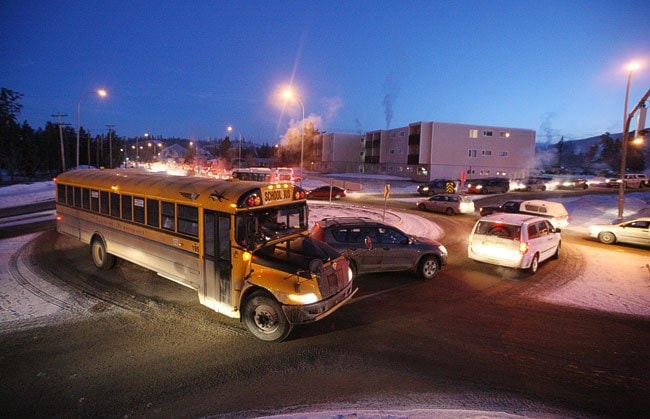Exhaust fumes and frustration hang in the air as commuter vehicles inch along Lewes Boulevard Tuesday morning.
It’s 8:25 a.m. and the Riverdale Rush is at its peak, with traffic backed up from Hospital Road all the way to Grey Mountain School, and in both directions along Alsek.
At the Nisutlin Road intersection, mayhem ensues while drivers try in vain to negotiate through the roundabout. Nobody seems to know exactly how to do it.
Some cars nose gingerly forward, hoping for a break in the lineup. Others charge, forcing their way in. One brave little subcompact tries to squeeze past the yellow enormity of a school bus on the inside, mounting the inside asphalt curb.
RELATED:Watch timelapse video of the roundabout here.
It doesn’t work. Both drivers gesticulate wildly.
Roundabouts: chances are if you live in Whitehorse, you have an opinion of them.
The city has been using the circular traffic devices for almost a decade now, but it seems that many Whitehorse residents still don’t know how to drive through them properly.
To address this, the city’s administration placed newspaper ads this week and printed brochures entitled “All About Roundabouts,” offering a gentle reminder to drivers that, among other things, please don’t ever stop in the roundabout.
Mayor Dan Curtis agrees that many drivers don’t know what they’re doing in the circular intersections.
“It’s the way we’ve always driven here, and I think it’s the way we’re always going to. We really need more education,” the mayor said.
“There are a lot of emotions about them. I know there are some people who are pretty adamant that they don’t want them, that they suck, but for me personally I think they are great at improving the traffic flow and keeping emissions down,” Curtis said.
There is a lot of science backing up Curtis’ words, as city engineer Wayne Tuck explained.
Roundabouts, when used properly, have been shown to reduce serious crashes in intersections, improve traffic flow and cut down on carbon emissions.
The majority of vehicle collisions occur at intersections, and the most dangerous ones are head-on or T-bone crashes resulting from a vehicle trying turn left into oncoming traffic. With a traffic circle, that doesn’t happen, and because everyone is moving in the same direction, those crashes that do still happen cause much less damage.
And, by keeping the majority of vehicles rolling instead of stopping and starting, traffic circles reduce gas consumption. Accelerating from a full stop uses almost 40 per cent more fuel than speeding up from a slow roll, according to Transport Canada. For a street that sees 4,000 cars per day, that means over 15,000 litres of extra fuel is burned per year for every additional stop sign put in place.
But to reap these benefits, all drivers must actually use roundabouts correctly.
On Tuesday morning in Riverdale, the confusion over roundabout rules was clear. Many drivers treated the roundabout like a carnival ride queue, with everyone taking their turn to enter. Vehicles often stopped in the middle, clogging the entire intersection, sometimes yielding to other drivers incorrectly.
Whitehorse resident Michael Vernon knows exactly what that looks like. Vernon grew up circling the U.K.‘s roundabouts and is a self-described “survivor” of Halifax’s notorious Armdale Rotary. As folklore tells it, that horrendous pair of side-by-side traffic circles - with their own stop lights, no less - trapped one unlucky driver for three days, until she ran out of gas.
“Roundabouts are great,” Vernon said, “but Whitehorse’s roundabouts are too small, and they’re in the wrong places. They’ve been used in some places - like 6th Ave - as misguided traffic calming measures.”
As Vernon sees it, larger circles would allow more time and space for drivers to enter together without risk of crashing. But that would require widening the roadway significantly every time the city wants to add a roundabout.
Some of the city’s traffic circles do work, Vernon said, such as the large one at the top of Robert Service Way near where it meets Hamilton Boulevard.
But unfortunately down at the bottom of the street, next to the S.S. Klondike, things are not so good.
“I once saw someone try to turn left through that circle,” Vernon said. Like most roundabouts, mistakes there are common.
“That happens a lot,” said Tuck.
“People want to be the Good Samaritan, but you don’t stop in a roundabout. If you have to stop, or you want to be a Good Samaritan, stop before you enter,” he said.
When you do enter, make sure to do it slowly. Yield to drivers who are already in the roundabout. Drive counterclockwise around the circle and always - Tuck emphasized this point - use your right-turn signal to indicate when you plan to leave. That way, other drivers waiting to enter will know what you’re up to and can enter from the other side without having to wait until you’ve completed the loop.
Tuck said he plans to print about 2,000 of the brochures, but they can also be downloaded from the city’s website and saved on mobile devices.
Contact Jesse Winter at
jessew@yukon-news.com
